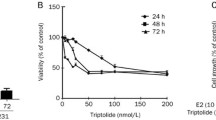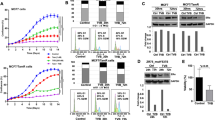Abstract
Purpose
Most hormone-dependent human breast cancers develop resistance to anti-hormone therapy over time. Our goal was to identify novel treatment strategies to avoid this drug resistance and thereby control hormone-dependent breast cancer.
Methods
Sulforhodamine B assays were used to measure viability of cultured human breast-cancer cells. BT-474 cell tumor xenografts in nude mice were used to evaluate tumor growth. Immunohistochemistry was used to assess estrogen-receptor and angiogenesis-marker expression, as well as apoptosis, in tumor-xenograft tissues.
Results
MCF-7 and BT-474 breast-cancer cells treated with either RO 48–8071 <[4′-[6-(Allylmethylamino)hexyloxy]-4-bromo-2′-fluorobenzophenone fumarate] [RO]; a small-molecule inhibitor of oxidosqualene cyclase, a key enzyme in cholesterol biosynthesis> or liquiritigenin [LQ; an estrogen receptor (ER) β agonist] exhibited significantly reduced viability in vitro. RO + LQ treatment further significantly reduced cell viability. Administration of RO, LQ, or RO + LQ significantly inhibited growth of BT-474 tumor xenografts in vivo. RO, LQ, or RO + LQ reduced ERα but induced ER β expression in tumor xenografts. Both compounds significantly reduced angiogenesis-marker expression and increased apoptosis in tumor xenografts; use of RO + LQ significantly enhanced the effects observed with a single agent.
Conclusion
The ERβ ligand LQ significantly enhanced the inhibition of breast-cancer cell viability and tumor-xenograft growth by RO. The anti-tumor properties of RO may in part be due to an off-target effect that reduces ERα and increases ERβ, the latter of which can then interact with LQ to promote anti-proliferative effects. The RO + LQ combination may have value when considering novel treatment strategies for hormone-dependent breast cancer.






taken from 4 to 5 animals and 26–30 areas were quantitated for VEGF, and 26–30 images were quantitated for CD31. Values represent means ± SEM. Insets for representative micrographs represent negative controls. Bars represent 50 μm. *Significantly different from controls; **Significantly different from all other groups (P < 0.05 using ANOVA)
Similar content being viewed by others
Data availability
Data will be available on request.
Abbreviations
- ANOVA:
-
Analysis of variance
- DCC:
-
Dextran-coated charcoal
- ER:
-
Estrogen receptor
- FBS:
-
Fetal bovine serum
- ip:
-
Intraperitoneal
- iv:
-
Intravenous
- LQ:
-
Liquiritigenin
- OSC:
-
Oxidosqualene cyclase
- PBS:
-
Phosphate-buffered saline
- RO:
-
RO 48-8071 <[4′-[6-(Allylmethylamino)hexyloxy]-4-bromo-2′-fluorobenzophenone fumarate]>
- sc:
-
Subcutaneous
- SEM:
-
Standard error of the mean
- SRB:
-
Sulforhodamine B
- TUNEL:
-
Terminal deoxynucleotidyl transferase dUTP nick end labeling
- VEGF:
-
Vascular endothelial growth factor
References
D’Abreo N, Hindenburg AA (2013) Sex hormone receptors in breast cancer. Vitam Horm 93:99–1331
Pasqualini JR, Katzenellenbogen BS (eds) (1996) Hormone dependent cancer. Marcel Dekker Inc, New York, p 579
Belachew EB, Sewasew DT (2021) Molecular mechanisms of endocrine resistance in estrogen-positive breast cancer. Front Endocrinol 12:599586
Fisher B, Redmond C, Fisher ER, Caplan R (1988) Relative worth of estrogen or progesterone receptor and pathologic characteristics of differentiation as indicators of prognosis in node negative breast cancer patients: findings from national surgical adjuvant breast and bowel project protocol B-06. J Clin Oncol 6:1076–1087
Harrell JC, Dye WW, Allred DC et al (2006) Estrogen receptor positive breast cancer metastasis: altered hormonal sensitivity and tumor aggressiveness in lymphatic vessels and lymph nodes. Cancer Res 66:9308–9315
Hyder SM (2006) Sex-steroid regulation of vascular endothelial growth factor in breast cancer. End Relat Cancer 13:667–687
Bailey ST, Shin H, Westerling T, Liu XS, Brown M (2012) Estrogen receptor prevents p53-dependent apoptosis in breast cancer. Proc Natl Acad Sci USA 109:18060–18065
Fernando RI, Wimalasena J (2004) Estradiol abrogates apoptosis in breast cancer cells through inactivation of BAD: ras-dependent nongenomic pathways requiring signaling through ERK and Akt. Mol Biol Cell 15:3266–3284
Schairer C, Lubin J, Troisi R et al (2000) Menopausal estrogen and estrogen progestin replacement therapy and breast cancer risk. JAMA 283(485):491
Li CI, Malone KE, Porter PL et al (2003) Relationship between long durations and different regimens of hormone therapy and risk of breast cancer. JAMA 289:3254–3263
Chlebowski RT, Hendrix SL, Langer RD et al (2003) Influence of estrogen plus progestin on breast cancer and mammography in healthy postmenopausal women: the women’s health initiative randomized trial. JAMA 289:3243–3253
Ross RK, Paganini-Hill A, Wan PC, Pike MC (2000) Effect of hormone replacement therapy on breast cancer risk: estrogen versus estrogen plus progestin. J Natl Cancer Inst 92(328):332
Cordera F, Jordan VC (2006) Steroid receptors and their role in the biology and control of breast cancer growth. Semin Oncol 33:631–641
White R, Parker MG (1998) Molecular mechanisms of steroid hormone action. Endocr Relat Cancer 5:1–14
Musgrove EA, Sutherland RL (2009) Biological determinants of endocrine resistance in breast cancer. Nat Rev Cancer 9:631–643
Hiscox S, Morgan L, Green TP (2006) Elevated Src activity promotes cellular invasion and motility in tamoxifen resistant breast cancer cells. Breast Cancer Res Treat 97:263–274
Bulun SE, Simpson ER (2008) Aromatase expression in women’s cancers. Adv Exp Med Biol 630:112–132
Nelson ER, Wardell SE, Jasper JS, Park S, Suchindran S, Howe MK, Carver NJ, Pillai RV, Sullivan PM, Sondhi V, Umetani M, Geradts J, McDonnell DP (2013) 27-Hydroxycholesterol links hypercholesterolemia and breast cancer pathophysiology. Science 342:1094–1098
Wu Q, Ishikawa T, Sirianni R et al (2013) 27-Hydroxycholesterol promotes cell-autonomous, ER-positive breast cancer growth. Cell Rep 5:637–645
Brufsky AM, Dickler MN (2018) Estrogen receptor-positive breast cancer: exploiting signaling pathways implicated in endocrine resistance. Oncologist 23:528–539
Charlton-Menys V, Durrington PN (2007) Squalene synthase inhibitors: clinical pharmacology and cholesterol-lowering potential. Drugs 67:11–16
Staedler D, Chapuis-Bernasconi C, Dehmlow H et al (2012) Cytotoxic effects of combination of oxidosqualene cyclase inhibitors with atorvastatin in human cancer cells. J Med Chem 55:4990–5002
Thoma R, Schulz-Gasch T, D’Arcy B et al (2004) Insight into steroid scaffold formation from the structure of human oxidosqualene cyclase. Nature 432:118–122
Ding X, Zhang W, Li S, Yang H (2019) The role of cholesterol metabolism in cancer. Am J Cancer Res 9:219–227
Liang Y, Besch-Williford C, Aebi JD et al (2014) Cholesterol biosynthesis inhibitors as potent novel anti-cancer agents: suppression of hormone-dependent breast cancer by the oxidosqualene cyclase inhibitor RO 48-8071. Breast Cancer Res Treat 146:51–62
Liang Y, Mafuvadze B, Aebi JD, Hyder SM (2016) Cholesterol biosynthesis inhibitor RO 48–8071 suppresses growth of hormone-dependent and castration-resistant prostate cancer cells. OncoTargets Ther 9:3223–3232
Mal R, Magner A, David J, Datta J, Vallabhaneni M, Kassem M, Manouchehri J, Willingham N, Stover D, Vandeusen J, Sardesai S, Williams N, Wesolowski R, Lustberg M, Ganju RK, Ramaswamy B, Cherian MA (2020) Estrogen receptor beta (ERβ): a ligand activated tumor suppressor. Front Oncol 10:587386
Liang Y, Zou X, Hyder SM (2020) Cholesterol biosynthesis inhibitor RO 48–8071 inhibits viability of aggressive cancer cells. Cancer Rep Rev 4(4):1–4
Maione F, Oliaro-Bosso S, Meda C et al (2015) The cholesterol biosynthesis enzyme oxidosqualene cyclase is a new target to impair tumour angiogenesis and metastasis dissemination. Sci Rep 5:9054
Mersereau JE, Levy N, Staub RE, Baggett S, Zogovic T, Chow S, Ricke WA, Tagliaferri M, Cohen I, Bjeldanes LF, Leitman DC (2008) Liquiritigenin is a plant-derived highly selective estrogen receptor beta agonist. Mol Cell Endocrinol 283:49–57
Liu Y, Xie S, Wang Y, Luo K, Wang Y, Cai Y (2012) Liquiritigenin inhibits tumor growth and vascularization in a mouse model of HeLa cells. Molecules 17:7206–7216
Kim YW, Zhao RJ, Park SJ, Lee JR, Cho IJ, Yang CH, Kim SG, Kim SC (2008) Anti-inflammatory effects of liquiritigenin as a consequence of the inhibition of NF-kappaB-dependent iNOS and proinflammatory cytokines production. Br J Pharmacol 154:165–173
Rubinstein LV, Shoemaker RH, Paull KD, Simon RM, Tosini S, Skehan P, Scudiero DA, Monks A, Boyd MR (1990) Comparison of in vitro anticancer-drug-screening data generated with a tetrazolium assay versus a protein assay against a diverse panel of human tumor cell lines. J Natl Cancer Inst 82:1113–1118
Liang Y, Besch-Williford C, Benakanakere I, Hyder SM (2007) Re-activation of p53 pathway inhibits growth of hormone-dependent human breast cancer cells in vitro and in vivo. Int J Oncology 31:777–784
Liang Y, Besch-Williford C, Benakanakere I, Thorpe PE, Hyder SM (2011) Targeting mutant p53 protein and the tumor vasculature: an effective combination therapy for advanced breast tumors. Breast Cancer Res Treat 125:407–420
Mafuvadze B, Benakanakere I, López Pérez FR, Besch-Williford C, Ellersieck MR, Hyder SM (2011) Apigenin prevents development of medroxyprogesterone acetate-accelerated 7,12-dimethylbenz(a)anthracene-induced mammary tumors in Sprague-Dawley rats. Cancer Prev Res 4:1316–1324
Liang Y, Besch-Williford C, Mafuvadze B, Brekken R, Hyder SM (2020) Combined treatment with p53-activating drug APR-246 and a phosphatidylserine-targeting antibody, 2aG4, inhibits growth of human triple-negative breast cancer xenografts. Cancer Rep Rev 4(2):1–10
Chen B, Wang Y, Kane SE, Chen S (2008) Improvement of sensitivity to tamoxifen in estrogen receptor-positive and Herceptin-resistant breast cancer cells. J Mol Endocrinol 41:367–377
Treeck O, Lattrich C, Springwald A, Ortmann O (2010) Estrogen receptor beta exerts growth-inhibitory effects on human mammary epithelial cells. Breast Cancer Res Treat 120:557–565
Paruthiyil S, Parmar H, Kerekatte V et al (2004) Estrogen receptor beta inhibits human breast cancer cell proliferation and tumor formation by causing a G2 cell cycle arrest. Cancer Res 64:423–428
Warner M, Gustafsson JA (2010) The role of estrogen receptor beta (ERbeta) in malignant diseases—a new potential target for antiproliferative drugs in prevention and treatment of cancer. Biochem Biophys Res Commun 396:63–66
Deroo BJ, Buensuceso AV (2010) Minireview: estrogen receptor-beta: mechanistic insights from recent studies. Mol Endocrinol 24:1703–1714
Ström A, Hartman J, Foster JS, Kietz S, Wimalasena J, Gustafsson JA (2004) Estrogen receptor beta inhibits 17beta-estradiol-stimulated proliferation of the breast cancer cell line T47D. Proc Natl Acad Sci USA 101:1566–1571
Yan S, Dey P, Ziegler Y, Jiao X, Kim SH, Katzenellenbogen JA, Katzenellenbogen BS (2021) Contrasting activities of estrogen receptor beta isoforms in triple negative breast cancer. Breast Cancer Res Treat 185:281–292
Mafuvadze B, Liang Y, Hyder SM (2014) Cholesterol synthesis inhibitor RO 48–8071 suppresses transcriptional activity of human estrogen and androgen receptor. Oncol Rep 32:1727–1733
Sotoca AM, van den Berg H, Vervoort J, van der Saag P, Ström A, Gustafsson JA, Rietjens I, Murk AJ (2008) Influence of cellular ERalpha/ERbeta ratio on the ERalpha-agonist induced proliferation of human T47D breast cancer cells. Toxicol Sci 105:303–311
Lindberg MK, Movérare S, Skrtic S et al (2003) Estrogen receptor (ER)-beta reduces ERalpha-regulated gene transcription, supporting a “ying yang” relationship between ER-alpha and ERbeta in mice. Mol Endocrinol 17:203–208
Williams C, Edvardsson K, Lewandowski SA et al (2008) A genome-wide study of the repressive effects of estrogen receptor beta on estrogen receptor alpha signaling in breast cancer cells. Oncogene 27:1019–1032
Thomas C, Gustafsson JA (2011) The different roles of ER subtypes in cancer biology and therapy. Nat Rev Cancer 11:597–608
Madeira M, Mattar A, Logullo AF, Soares FA, Gebrim LH (2013) Estrogen receptor alpha/beta ratio and estrogen receptor beta as predictors of endocrine therapy responsiveness-a randomized neoadjuvant trial comparison between anastrozole and tamoxifen for the treatment of postmenopausal breast cancer. BMC Cancer 13:425
Hartman J, Lindberg K, Morani A et al (2006) Estrogen receptor beta inhibits angiogenesis and growth of T47D breast cancer xenografts. Cancer Res 66:11207–11213
Acknowledgements
Supported in part by a Department of Defense Breast Cancer Program Grant W81XWH-12-1-0191, and by a Faculty Research Grant from the University of Missouri, Columbia. SMH is the Zalk Missouri Professor of Tumor Angiogenesis.
Author information
Authors and Affiliations
Corresponding author
Ethics declarations
Conflict of interest
Authors do not have conflict of interest.
Ethical approval
All animal studies were approved by ACUC at the University of Missouri.
Additional information
Publisher's Note
Springer Nature remains neutral with regard to jurisdictional claims in published maps and institutional affiliations.
Rights and permissions
About this article
Cite this article
Liang, Y., Besch-Williford, C. & Hyder, S.M. The estrogen receptor beta agonist liquiritigenin enhances the inhibitory effects of the cholesterol biosynthesis inhibitor RO 48-8071 on hormone-dependent breast-cancer growth. Breast Cancer Res Treat 192, 53–63 (2022). https://doi.org/10.1007/s10549-021-06487-y
Received:
Accepted:
Published:
Issue Date:
DOI: https://doi.org/10.1007/s10549-021-06487-y




